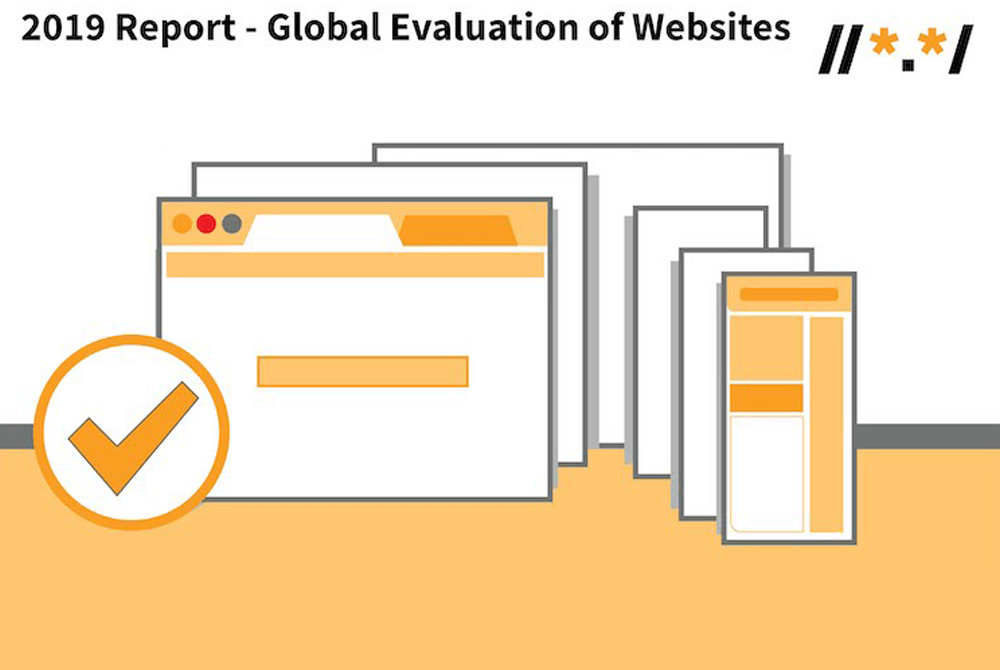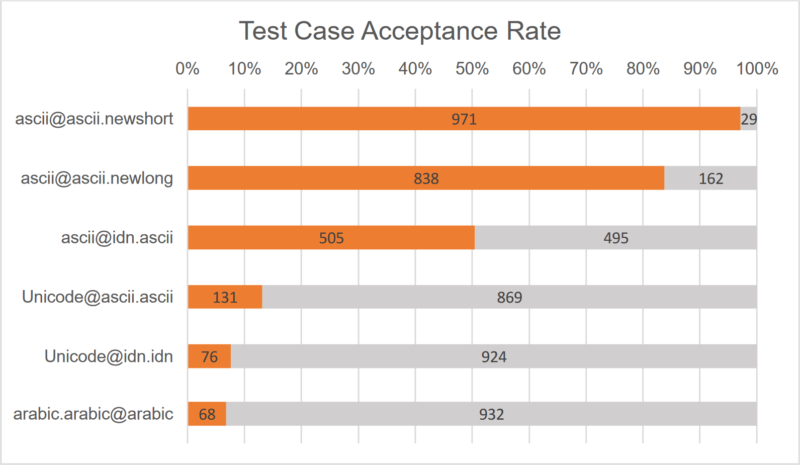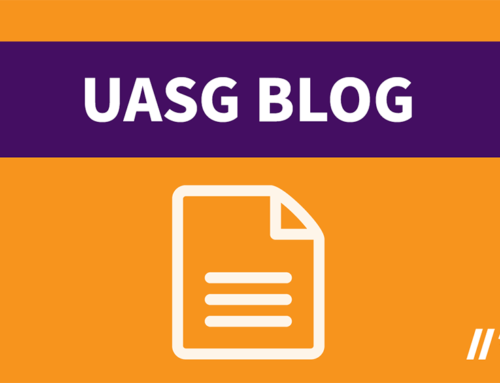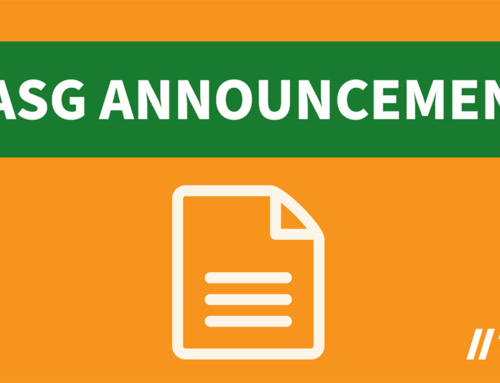Are the World’s Top Websites Truly Accessible for Global Audiences? An Evaluation of Acceptance of Email Addresses in 2019.
By Mark W. Datysgeld, UASG Ambassador and research coordinator for this evaluation
The Domain Name Space on the Internet is more inclusive than ever – with more than 1,500 new top-level domain names (TLDs) in varying character lengths and scripts, Internet users and organizations around the world can choose an online identity that best reflects them. However, there are differing degrees of online acceptance of these new domain names. To understand the progress towards achieving a truly inclusive Internet, we evaluated the top 1,000[1] websites in the world for their ability to accept test email addresses that represent the following range of new domain names:
| Test Case | Test Email Address |
| ascii@ascii.newshort | test@test.exp |
| ascii@ascii.newlong | test@test.example |
| ascii@idn.ascii | test@普遍接受-测试.org |
| unicode@ascii.ascii | 测试1@test.org |
| unicode@idn.idn | 测试5@普遍接受-测试.世界 |
| arabic.arabic@arabic (Right-to-left) | السعودية.رسيل@دون |
We used these six mailboxes to interface with the form fields on each of the selected 1,000 websites. The test email addresses incorporate increasing levels of complexity in relation to the more widely used ASCII-based[2] legacy domain rules – including new short TLDs (typically 2-3 characters, e.g., .eco), new long TLDs (more than three characters, e.g., .photography), and Internationalized Domain Names or IDNs (TLDs in various scripts, e.g., Arabic, Chinese or Cyrillic). To evaluate the sites, we extracted data from Amazon’s Alexa analytics tool and, drawing from its top global websites list1, found test cases with e-mail form fields that we proceeded to test. Every site earned either an “Accepted” or “Rejected” status for each of the six examples. A “Rejected” status was given when the website: A) displayed an error when the email address was typed B) returned an error message once submitted or C) if the submission was not allowed.
Here’s the bottom line
The good news is that the new short TLDs have a near complete acceptance rate among the websites evaluated (97 percent) This trend leaves us optimistic that the acceptance of new long TLDs (current acceptance rate of 84 percent ) will follow suit in the near term.
However, there’s much more work to be done when it comes to the acceptance of other test case TLDs (such as internationalized email addresses, with a current acceptance rate of 8 percent). For example, looking at just the top 100 websites around the world we found that only five accepted all of the test cases. Even if we exclude the more complex “unicode@idn.idn” and the Arabic (Right-to-left) test cases, there are still only nine websites accepting the first four test cases. These findings mean that while there are billions of people online, most cannot engage with websites using the online identity they would prefer. See below for a breakdown of the test case acceptance rates.
[1] The research team identified the top 1,000 websites according to Amazon’s, Alexa analytics tool. In order to be considered, the website had to meet two criteria – it could not be considered malware and it had to have an email input field somewhere on the site. Content subject matter was not taken into consideration. Using these criteria, the team found that only 527 of Alexa’s top 1,000 sites were viable; however, the team was able to identify 1,000 testable sites by expanding down the Alexa list to the 1,922nd website.
[2] ASCII – American Standard Code for Information Interchange, is a character encoding standard for electronic communication. https://en.wikipedia.org/wiki/ASCII
The goal in undertaking this test was to understand the extent of bottlenecks and compatibility issues facing all domain names available so they can ultimately be corrected. While the results point to an increasing adoption of new short and newlong TLDs, it’s clear that more effort from the Internet community is needed to increase the acceptance of emails in different scripts.
What does this mean for you?
Well, the first thing you should do is fully grasp the concept of Universal Acceptance of domain names and email addresses and review this introductory document. From there, you can access a number of materials and technical guides to better understand how systems can support the global Internet community. You are also encouraged to reach out to learn more from the UASG at info@uasg.tech or engage on Twitter, LinkedIn or Facebook.
Full test results, including methodology, for this evaluation can be found here.[1]
Additional Research on Universal Acceptance Readiness:
- February 2019, a member of the UASG conducted a test to determine the EAI-readiness in TLDs.
- Based on an examination of about 1,250 TLDs, 7 percent of the mail servers based on the domains sampled were EAI-ready. The TLDs measured ranged from the largest, .COM, down to smaller TLDs with a handful of names. In the largest TLDs (over a million names), 10.5 percent of the mail servers based on the domains sampled were EAI-ready.
- IDN TLDs were significantly less ready than non-IDN (4.7 percent rather than 9.8 percent ), but most IDN TLDs are small and none of the ones sampled have many active mail servers. Full test results, including methodology, can be found here.
- In October 2018, members of the Brazilian Association of Software Companies (ABES), ICANN’s Business Constituency, Fellowship/NextGen Alumni, with support from the LAC GSE and UASG, conducted a study to measure the UA-readiness of the 50 most popular websites in Brazil (according to Alexa rankings).
- Out of the 50 Brazilian websites, only three achieved total Universal Acceptance compliance: content portal IG (com.br), download website Baixaki (baixaki.com.br), and the government’s Ministry of Education (mec.gov.br). Full test results, including methodology, can be found here.
[3] Test results also available in Español | Français | عربى | 中文 | Pусский







